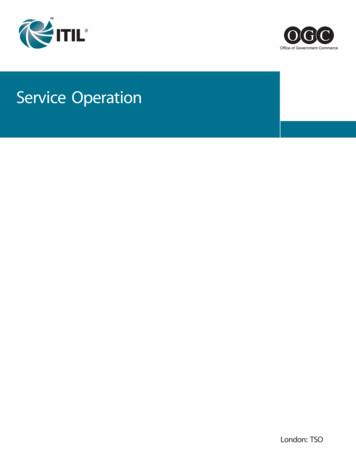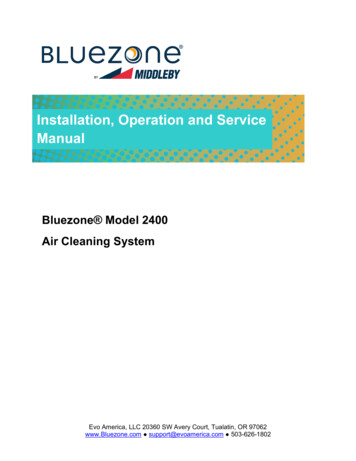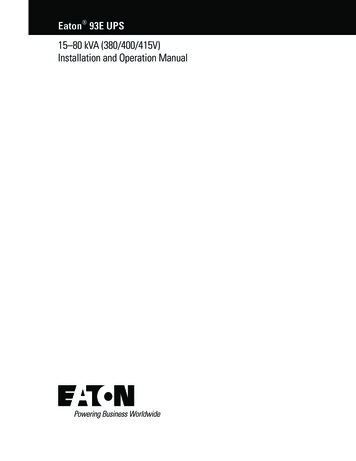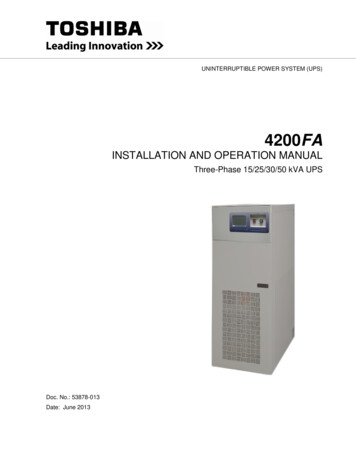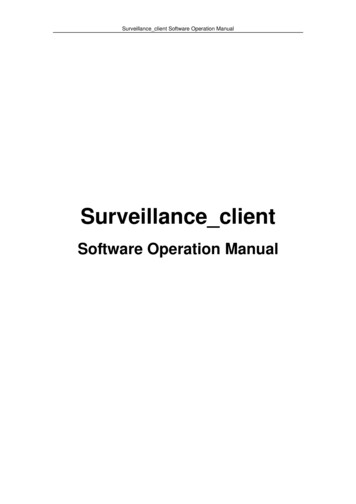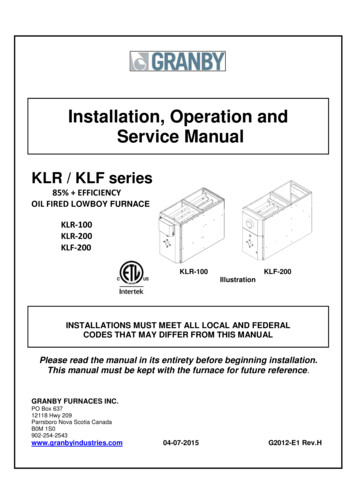
Transcription
Installation, Operation andService ManualKLR / KLF series85% EFFICIENCYOIL FIRED LOWBOY tionINSTALLATIONS MUST MEET ALL LOCAL AND FEDERALCODES THAT MAY DIFFER FROM THIS MANUALPlease read the manual in its entirety before beginning installation.This manual must be kept with the furnace for future reference.GRANBY FURNACES INC.PO Box 63712118 Hwy 209Parrsboro Nova Scotia CanadaB0M 2012-E1 Rev.H
TABLE OF CONTENTSKLR-KLFOil1.0IMPORTANT SAFETY ADVICE22.0PRODUCT INFORMATION33.0FURNACE INSTALLATION74.0ACCESSORIES INSTALLATION95.0BURNER INSTALLATION AND SPECIFICATIONS5.1 ASSEMBLY & INSTALLATION OF BURNER5.2 SET BURNER FOR EFFICIENT OPERATION5.3 KLR TECHNICAL INFORMATION5.4 KLF TECHNICAL INFORMATION11111214156.0FURNACE OPERATION AND SETTINGS6.1 BLOWER SETTING6.2 FAN TIMER CONTROL BOARD (ST9103 A 1028)6.3 (ST9103 A 1028) CONTROL BOARD SEQUENCE6.4 SERVICING – FAN TIMER (ST9103 A 1028)16161718197.0SERVICE218.0ELECTRICAL / WIRING DIAGRAMSHEATING & COOLING – RIELLO BURNERHEATING & COOLING – BECKETT BURNERHEATING ONLY (2 WIRES THERMOSTAT)9.0EXPLODED PARTS VIEWKLR-100KLR-200KLF-2002828303210.START-UP TEST RESULTS34242425271
1.0 IMPORTANT SAFETY ADVICEPlease read and understand this manual before installing, operating or servicing thefurnace. To ensure you have a clear understanding of the operating procedures of the unitplease take the time to read the IMPORTANT SAFETY ADVICE section of this manual.WARNINGSNEVER burn garbage or paper in the unit.NEVER store combustible material around it.DO NOT attempt to start burner when excess oil has accumulated, when unit is full of vapouror when heat exchanger is very hot.DO NOT use gasoline, crankcase draining’s or any oil containing gasoline.CAUTIONDO NOT START THE BURNER UNTIL ALL FITTINGS, COVERS AND DOORS ARE INPLACE. DO NOT TAMPER WITH THE FURNACE OR CONTROLS, CALL A QUALIFIEDBURNER TECHNICIAN. DO NOT STORE OR USE GASOLINE OR OTHER FLAMMABLEVAPOURS AND LIQUIDS IN THE VICINITY OF THIS UNIT OR ANY OTHER APPLIANCE.DANGERDo not use this furnace as a construction heater. Use of this furnace as a constructionheater exposes it to abnormal conditions, contaminated combustion air and lack of airfiltering. Failure to follow this warning can lead to premature furnace failure which couldresult in a fire hazard and/or bodily harm and/or material damage.IMPORTANTThis manual contains instructional and operational information for the KLR / KLF OIL-FIREDFURNACE. Read the instructions thoroughly before installing furnace or starting the burner.Consult local authorities about your local FIRE SAFETY REGULATIONS. All installationsmust be in accordance with local state or provincial codes. Improper installation will result invoiding of warranty.2
2.0 PRODUCT INFORMATIONCLEARANCE (minimum) TO COMBUSTIBLESTop of Supply Plenum1”(25 mm)Front (Maintenance)24”(610 mm)Rear (Maintenance)24”(610 mm)Side – Non-Access1”(25 mm)Side – Access maintenance24”(610 mm)Flue Pipe9”(229 mm)Floor (Can be installed directly on combustible or non-combustible)DRAFT PRESSUREBreech draft pressure-0.01” wc minimumAIR/BLOWER DATAMaximum external static pressureMaximum cooling unit capacityMaximum air temperature riseHigh Limit temperatureThermostat anticipator0.5” wc3.0 tons. KLR-1005.0 tons KLR-2005.0 tons KLF-200See pages 14 (KLR), 15(KLF) and 35185 FSee thermostat instructionsMOTOR/BLOWERKLR-100: 1/2 hp 4 Speed / G10-8 DD or 1/2 hp ECM / G10-8KLR-200: 3/4 hp 4 Speed / GT12-10DD or 3/4 hp ECM / GT12-10KLF-200: 3/4 hp 4 Speed / GT12-10DD or 3/4 hp ECM / GT12-101/2 hp ECM /GT12-10 with a firing rate of 0.75 USGPHFAN/HIGH LIMIT CONTROLHoneywell ST9103A1028 Fan Center & Thermo-Disk (7” stem)THERMOSTATAny wall thermostatFUELNot heavier than No. 2 furnace oil.ELECTRICAL – 120 Volts, 60 HzCanadaLess than 12 amps, circuit protection 15 amps.USA13.3 amps, circuit protection 20 amps.3
FLUE-PIPE CONNECTION5” Chimney or Direct Vent DVS Granby kitCLEANOUTSRear Cover & Burner OpeningAIR FILTERSKLR-100KLR-200KLF-20020” x 20” x 2” non pleated UL approved15” x 20” x 2” & 20” x 20” x 2” non pleated UL approved15” x 20” x 2” (2X) non pleated UL approvedPLENUM DIMENSIONS (KLR-100)Cold air return(A)20” x 20”Hot air supply(B)20” x 20”Plenum spacing (C)2-1/8”(508 x 508 mm)(508 x 508 mm)(54 mm)PLENUM DIMENSIONS (KLR-200)Cold air return(A)20” x 22”Hot air supply (B)20” x 24”Plenum spacing (C)2-1/8”(508 x 559 mm)(508 x 610 mm)(54 mm)PLENUM DIMENSIONS (KLF-200)Cold air return(A)20” x 20”Hot air supply(B)20” x 24”Plenum spacing (C)2”(508 x 508 mm)(508 x 610 mm)(51 mm)BCKLRABCAKLF4
DIMENSIONS 248 mm)(838 mm)(546 mm)DIMENSIONS 400 mm)(838 mm)(546 mm)DIMENSIONS ��(1337 mm)(892 mm)(546 mm)KLR-100 - DIMENSIONSDimensions are in inches5
KLR-200 – DIMENSIONSDimensions are in inchesKLF-200 – DIMENSIONSDimensions are in inches6
3.0 FURNACE INSTALLATIONOIL TANK & PIPINGTank installation must conform to local requirements.Install according to the applicable code such as CSA B139 and NFPA 31. Minimize number ofconnections in suction line and make all connections air tight. Use a pipe joint compoundsuitable for oil on all pipe threads. To reduce possibility of air leaks, tighten stem packinggland nut on any valves installed in the suction line. Also, be sure the oil filter is tight, as filtergaskets often shrink. Check for kinks in the oil lines as well as for possible air pockets and forloose connections. Two filters as shown below are recommended. Optional tank gaugeprotectors and outlet protectors are available at your local dealer.ONE PIPE SYSTEMWhere the tank outlet is above the burner and when the oil flows bygravity to the oil pump, a single-stage fuel unit with a single oil lineto the pump may be used.TWO PIPE SYSTEMWhen a single line is not suitable, use double line or contact yourdealer for special oil line fittings. Install by-pass plug on burner fuelpump as specified in the burner manual.(HIGHLY RECOMMENDED)REAR FLUE FURNACE ILLUSTRATIONOil Tank and Piping7
PLACEMENT & VENTINGFurnace installation shall conform to the required installation code for oil-fired equipment (USA:NFPA 31, Canada: CSA B139).FLOOR SUPPORTCOMBUSTIBLE – If required, support furnace on five (5) concreteblocks. Make sure the center of the furnace base is supported. For afurnace installed on a combustible floor, consult the applicable code andauthorities having jurisdiction on this application. The floor must supportthe weight.CHIMNEY/VENTConnect the furnace to a chimney/vent system of size and conditionrequired by the NFPA 31 (USA) or CSA B139 (Canada) code. Furnaceis approved for factory built chimney type “L” vents. Breech is certifiedfor 5” vent pipe. Keep vent/flue pipe as short as possible with min. 1/4”per foot upward slope. Vent/flue pipes MUST NOT pass through aceiling. Maximum flue gas temperature is 575 F.CONDENSATIONIf you have condensation in your chimney, make sure that thechimney size is according to the tables in CSA B139 / NFPA 31.The temperature at the base of the chimney can be increased byinsulating the flue-pipe between the furnace and the chimney base.If this is not sufficient, consider cutting or removing some fluebaffles in the furnace. BE AWARE THAT REMOVING BAFFLESREDUCES THE UNIT’S EFFICIENCY AND A MODIFIED UNIT IS NOLONGER ENERGY STAR APPROVED.COMBUSTION &VENTILATION AIRInstall openings and ductwork to the furnace room providing fresh outside combustion and circulation air for cooling the furnace casing, asinstallation code requires (USA NFPA 31, Canada CSA B139). Ifinstalled in a closed room, provide two free air ventilation openings of atleast 8” x 12” (96 sq. in.) free flow area near ceiling and floor. Oilburners must have sufficient air to allow vent systems to operateproperly.BREECH DRAFTUse approved draft control supplied for 5” pipe. Set draft pressure of theflue to -0.01” wc.ELECTRICALWire according to the National Electrical Code (Canadian ElectricalCode in Canada) or local codes. Use a separately fused #12 electricalline directly from the service panel to the furnace junction box. Install amanual shut-off switch at the door or stairway to furnace room sofurnace can be shut off remotely.CLEARANCESBefore placing unit, review installation clearances as shown on furnaceoperating decal or section PRODUCT INFORMATION (page 3).LOCATIONInstall the furnace close to chimney and central to ductwork.8
4.0 ACCESSORIES INSTALLATIONBLOCKED VENT SWITCH (BVSO) FOR CANADIAN APPLICATION ONLYOil-fired appliances installed in Canada require a blocked vent switch system when installed ona chimney. A safety switch is included with the furnace to perform this function. It is theinstaller’s responsibility to install the switch in accordance with the instructions provided. Notapplicable for direct vent systems. Field Controls Model: WMO-1 (Manual Reset)Switch OperationBlocked vent switches are flue gas safety devices for detecting spillage of flue gases due to ablocked flue or inadequate draft. After detecting a problem, the switch de-energizes thesystem’s burner control.NEVER reset the switch unless the cause of the blockage has been corrected.Installation1)2)3)4)5)6)Drill a 5/8” hole in to the flue vent pipe near the appliance breech connection.This hole must be before the draft regulator, vertically or horizontally.Remove one of the securing nuts from the threaded tube of the safety switch.Tighten the other securing nut onto the pipe as far as possible (Figure 1).Insert the threaded tube end into the pierced hole of the flue vent pipe.Install the securing nut on the safety switch tube, which protrudes into the flue vent pipe.Tighten the nut securely (Figure 1).Figure 1 - Illustration Granby IndustriesFigure 2 - BVSO wiring diagramWiring Instructions (BVSO)Caution: Disconnect the electrical power when wiring the unit.Wire the blocked vent switch in accordance with The National Electrical Code and applicablelocal codes. Wire the safety switch (BVSO) in series with the thermostat and the fan timerrelay control (Figure 2).9
System Test Procedure (BVSO)1) With the power re-established, block the chimney or vent pipe downstream of the switch.2) Adjust the thermostat to call for heat.3) Once the heating system has started the blocked vent switch should shut down the burnerwithin 10 minutes or sooner.4) Once the system has cooled, the blocked vent switch can manually be reset.5) This procedure should be tested a second time.6) After testing the blocked vent switch the chimney should be cleared of obstruction and theheating system should be tested over a long run cycle.If the block vent switch shuts down the system, check to ensure there is enough draft in thechimney and venting pipes.AIR CONDITIONINGAn air conditioning coil may be installed on the supply side only. Coils installed on the returnside will cause condensation on the heat exchanger; this will shorten the heat exchanger lifeand may cause products of combustion to enter the house. Wire as per wiring label anddiagram. Height of the coil above the unit supply shall be at least 4” (102 mm).4 inchminimumKLR4 inchminimumKLFSee A/C coil Manufacturers Requirements.To check the AC coil total air flow resistance, see procedure at page 35.HUMIDIFIERIf a humidifier is installed ensure that no water can drip or run from it into the furnace. Thiswould cause deterioration and void the furnace warranty.10
5.0 BURNER INSTALLATION AND SPECIFICATIONS5.1 ASSEMBLY & INSTALLATION OF BURNERASSEMBLYCheck that the burner model is correct for furnace rating required.Assemble as per burner manufacturer’s instructions.SELECT NOZZLESelect oil input, nozzle and burner configuration as shown on furnaceoperating decal.INSTALL NOZZLEInstall selected nozzle, check for clean seating and tighten in nozzleadaptor.ELECTRODESSee burner manufacturer’s instructions for correct settingINSERTIONMOUNT BURNERTighten top nut first so burner tips downslightly. The burner is always installed inan upright position by four (4) nuts.PUMP BY-PASSPLUGFor one pipe system factory setting (noplug).WIRINGRefer to wiring diagram for correct burnerconnections (see page 24,25,26 or 27).THERMOSTATConnect the thermostat wires to the fantimer control board (ST9103).11
5.2 SET BURNER FOR EFFICIENT OPERATIONBURNER SETTINGUse burner settings in the table on page 14 (KLR) and 15 (KLF) oroperating decal as a guide to set burner, particularly for nozzlechanges.Those settings are only starting points for theadjustments and are not meant as final settings.On Beckett AFG burner, make sure the correct retention head andstatic disk are installed on the burner for the desired firing rate. Thehead is held in place by two screws at the end of the burner blast tube.From the burner technical information table on page 14 (KLR) and 15(KLF), the head is always after the AFG designation and the static diskafter the head. For example, the AFG L2 3’’ 3/8 means an AFGchassis burner with a L2 head and a static disk of 3’’ 3/8.PUMP PRESSURERefer to the table on page 14 (KLR) and 15 (KLF) or operating decal.AIR SETTINGUse air settings on page 14 (KLR) and 15 (KLF) as a guide to set airadjustment. Those settings are only starting points for theadjustments and are not meant as final settings.DRAFT REGULATOR The draft regulator should be installed at least 3 flue pipe diameterfrom breeching or elbow of the furnace.SAMPLING HOLEOn smoke/vent pipe, drill a 3/8” round opening. The hole should be atleast 2 flue pipe diameter from breeching or elbow of the furnace.FRONT FLUE FURNACE ILLUSTRATION12
DRAFT PRESSUREUsing an accurate draft meter; adjust the draft control to obtain aminimum of -0.01” wc draft pressure at the breech sampling hole. Thedraft regulator’s adjustments should be made after furnace has beenrunning under heating mode for at least 5 minutes.COMBUSTION TESTAll your tests must be done with the burner cover on (Riello)COMBUSTIONSETTING/EFFICIENCYAfter 10 minutes of normal operation, take a smoke test and adjustthe burner to obtain a reading of “1” on the smoke scale. Take a CO2test and note the result.To reach the maximum smoketest value, a 10 full slow steadypump action is required.Open the air band adjustment on the burnerto reduce your CO2 lecture by 1%.CO2 test can be done mechanically or electronically(18 full slow steadypump action)You now have a small “slight trace” of smoke.Relation between % of CO2 and O2CO2 (%)O2 (%)Excess Air 0.025.030.035.040.013
5.3 KLR TECHNICAL INFORMATIONKLR SeriesKLR-100KLR-200F3F5Riello BurnerUnit ModelFiring Rate (USGPH)Input (BTU/h)Output (BTU/h)NozzlePump Pr. 2 pipes sys. (psi)Pump Pr. 1 pipe sys. (psi)Turbulator SettingAir Gate AdjustmentEnergy Star ApprovedAFUE 0000.40 70A19019001.75YES86.800.6591,00079,0000.60 70W14516502YES87.000.75105,00091,0000.65 70W14516502.35YES86.200.90126,000109,0000.75 80W14516502YES88.001.05147,000126,0000.85 70W16517512.25YES87.401.15161,000139,0001.00 70W14516522.25YES86.80Beckett BurnerUnit ModelFiring Rate (USGPH)Input (BTU/h)Output (BTU/h)NozzleLow Firing Rate BafflePump Pressure (psi)Air Band (Gross)Air Shutter (Fine)Energy Star ApprovedAFUE (%)AFG L2 3-3/8KLR-G2-*066-03 KLR-G2-*078-03AFG F3 2-3/4KLR-G2-*090-03KLR-G2-*102-05 KLR-G2-*119-05 KLR-G2-*132-050.5577,00066,0000.50 60WNO145N/A4YES87.000.6591,00078,0000.60 60WNO145N/A5.5YES87.100.75105,00090,0000.65 60WNO145N/A7YES86.300.85119,000102,0000.75 70BYES14517YES87.501.00140,000119,0000.85 70BYES14526YES87.201.10154,000132,0001.00 70BYES145210YES86.5012.513.513.512.513.513.555 – 85M-LOWM-HIGH55 – 85M-HIGHM-HIGH55 – 85M-HIGHHIGH55 – 85M-LOWM-HIGH55 – 85M-HIGHHIGH55 – 85M-HIGHHIGH55-85MEDIUM60-85M-HIGHCO2 (%)General InformationPSC motor infoTemperature Rise ( F)Blower Speed (0.2’’ wc)Blower Speed (0.5” wc)Energy Star ECM motor (0.2’’ wc to 0.5’’ wc static pressure)Temperature Rise ( F)Blower c Pressure at 0.2'' WC / 0.5'' WCBlowerSpeedHIMHIMEDMLOLOPSC 1/2 hp0.2" wc0.5" wc1375127512501170----11001075875850PSC 3/4 hp0.2" wc0.5" IMHIMEDMLOLOECM 1/2 hp0.2" wc 0.5" wc1300123012251160114010501025980775750ECM 3/4 hp0.2" wc0.5" wc2000191019001835169016601610157510601010(*) In the Unit Model number, is specific information of the product for administration only.14
5.4 KLF TECHNICAL INFORMATIONKLF SeriesKLF-200F5Riello BurnerUnit ModelFiring Rate (USGPH)Input (BTU/h)Output (BTU/h)NozzlePump Pr. 2 pipes sys. (psi)Pump Pr. 1 pipe sys. (psi)Turbulator SettingAir Gate AdjustmentEnergy Star ApprovedAFUE (%)KLF-E3-*102-050.85119,000102,0000.75 70W14516502YES87.50Beckett BurnerUnit ModelFiring Rate (USGPH)Input (BTU/h)Output (BTU/h)NozzleLow Firing Rate BafflePump Pressure (psi)Air Band (Gross)Air Shutter (Fine)Energy Star ApprovedAFUE (%)KLF-E3-*119-051.00140,000119,0000.85 ,0001.00 70W14516522.25YES86.50AFG F3 2-3/4KLF-G2-*102-030.85119,000102,0000.75 00.85 01.00 70WYES145210YES86.3013.513.512.555 - 85M-HIGHM-HIGH55 - 85HIGHM-HIGH55 - 85HIGHHIGHCO2General InformationPSC motor infoTemperature Rise ( F)Blower Speed (0.2’’ wc)Blower Speed (0.5” wc)Energy Star ECM motor (0,2'' wc to 0,5'' static pressure)Temperature Rise ( F)Blower Speed52-8055-8555-85M-LOWMEDIUMMED-HIStatic Pressure at 0.2'' WC / 0.5'' WCBlowerSpeedHIMHIMEDMLOLOPSC 3/4 hp0.2" wc0.5" wc21202030194018751710165011501050ECM 1/2 hp0.2" wc0.5" wc13001230122511601140105010259807757500.2" wc20001900169016101060ECM 3/4 hp0.5" wc19101835166015751010(*) In the Unit Model number, is specific information of the product for administration only.15
6.0 FURNACE OPERATION AND SETTINGSSHUTTING FURNACE DOWNPOWER OFFTurn off main power breaker or disconnect.FUEL OFFShut off manual fuel supply valve.Always keep manual fuel supply valve shut off if the burner is shut down for an extendedperiod of time.RESTARTING FURNACEFollow this procedure before restarting a unit that has been shut down for an extended periodof time.INSPECTIONHave the furnace/system serviced and inspected by a qualified technician.FUELTurn on fuel supply and check that there are no leaks.POWERTurn on power and check that the furnace starts and operates as usual.OPERATIONIf the furnace/system fails to operate or operates in an unusual manner, callyour service technician. If the burner fails to operate at any time, call aqualified burner technician.6.1 BLOWER SETTINGEnsure power is off when adjusting blower setting. For heating, use the blower speedsshown on the furnace specifications to give a temperature rise according to the technicalinformation tables on page 14 (KLR) and 15 (KLF). The Lo blower speed can be used for aircirculation when heating or cooling are not required. Set blower speeds to match theinstallation requirements.FAN & LIMIT CONTROLLimitFan OnFan Off185 F – Factory set45 seconds after the burner startsAdjustable on board (see page 17)THERMOSTAT ANTICIPATOR SETTINGAdjust to thermostat manufacturer’s instruction.16
6.2 FAN TIMER CONTROL BOARD (ST9103A 1028)o “FAN OFF” Dip Switches adjustmentDip SwitchesCOMFORT ADJUSTMENTSo Outlet air consistently too warm or too cold - change the blower motor speed to give thespecified air temperature rise.o Outlet air gets too warm and burner shuts down - increase air by changing the blowermotor speed to give the specified temperature rise.o Outlet air is too cold or too warm at the end of the heating cycle after the burner hasturned off - adjust the “FAN OFF” dip switch on fan timer control board. Refer to the nextfigure.“FAN OFF” Dip SwitchDip Switch adjustment (90 seconds) on all unit inputExcept for Beckett burner 0.55 nozzle60 seconds adjustmentOFF CYCLE AIR CIRCULATION (Factory settings)LO SPEEDAll KLR / KLF models have the Lo speed switch for optional constant aircirculation during the furnace off cycle.“FAN ON”When “FAN ON” is selected on the thermostat, the blower will run constantlyat the blower speed selected on the heating terminal. This is the equivalentof jumping terminals R and G on the ST9103 board.17
6.3 ST9103A 1028 CONTROL BOARD SEQUENCEST9103 Heating Sequence1)2)3)4)5)Thermostat calls for Heat.Burner startsBlower starts after 45 secondsBurner shuts down after call for heat is satisfiedBlower stops according to adjusted (FAN OFF) Dip switch selectionST9103 Cooling Sequence1)2)3)4)5)Thermostat calls for coolingBlower starts immediatelyCooling unit startsBlower stops immediately after cooling demand is satisfiedCooling unit stopsHoneywell ST9103A 1028 Electronic BoardKLFKLR18
6.4 Servicing - Fan Timer ST9103A 1028Trouble shooting the Honeywell electronic board ST9103Before trouble shootingthe board,check for the 5 amp. fuseFor accurate trouble shooting, follow step by step the Trouble Shooting Chart.StepPossible CauseCheck-out procedureCorrective actionNo Heat123Incoming supplyTransformerElectronic FancontrolCheck for 120 Voltsbetween terminal S2 and 3on electronic fan controlCheck for 120 Volts betweenterminal S3 and 4 onelectronic fan control.Check for 24 Volts betweenterminal X and C onelectronic fan controlCheck for 24 Volts betweenR and CCheck for 24 Volts betweenterminal W and CYes - Move to next stepNo - Check breaker main power switchYes - Move to next stepNo - Check for bad connectionYes - Move to next stepNo - Change TransformerYes - Move to next stepNo - Change the electronic boardYes - Move to next stepNo - Check thermostat and wiringWarning: Make sure the quick connect cable is fully inserted on the board4Limit ControlCheck for 120 Volts on eachterminal of the high limitYes - Move to step # 5No - Move to next stepCheck for 120 Volts comingfrom the main plug-in of theelectronic fan control to thelimit controlYes - Move to next stepNo - Change the electronic fan controlCheck for 120 Volts comingout of the limit controlYes - Move to step # 5No - Failure on the limit control circuit. Temperature too high. Bad limit control19
StepPossible CauseCheck-out procedureCorrective actionNo Heat5ARiello burnerapplicationCheck for 120 Volts on theblack wire, contact (COM)on the burner activationrelayYes - Move to next stepNo - Back to step # 4 or check for badconnectionCheck if oil primary controlis on resetYes - Press reset buttonNo - Move to the next stepCheck for continuitybetween the two wiresyellow and violet on theburner activation relayYes - Move to next stepNo - Change the electronic fan controlCheck for 120 Volts on thecontact (No) of the burneractivation relayYes - Move to next stepNo - Change the burner activation relayCheck for 120 volts on theorange wire coming to theburner (L)5B6Beckett BurnerapplicationBlower. Low speedCheck if theconstant lowspeed switch isONCheck for 120 Volts onterminal strip (COM) of theburner activation relayCheck if oil primary controlis on Reset and by-pass on(TT)Check for continuitybetween the two wiresyellow and violet on theburner activation relayYes - Failure on the burnerNo - Change the electronic fan controlYes - Move to next stepNo - Back to step # 4 or check badconnectionYes - Press reset button, check bypass on (TT)No - Move to the next stepYes - Move to next stepNo - Change the electronic fan controlCheck for 120 Volts on thecontact (NO) on the burneractivation relayYes - Move to next stepNo - Change the burner activation relayCheck for 120 Volts on theorange wire coming to theburnerYes - Failure on the burnerNo - Change the primary controlCheck for 120 Volts at the''CONT'' terminal on theelectronic fan controlYes - Move to next stepNo - Change the electronic fan controlCheck for 120 Volts on both Yes - Check ''LOW'' speed on theblower motorside of the constant lowspeed switchNo - Change the switch20
StepPossible CauseCheck-out procedureCorrective action(No) Cooling / HeatingBlowerHigh speed.7Cooling SpeedHeating Speed(45 sec. delay)StepYes - Move to next stepCheck for 24 Volts between GNo - Check thermostat and wiring; if it'sand C on electronic fanOK, then change the electronic fancontrolcontrolCheck for 120 Volts at the''COOL'' terminal of theelectronic fan controlCheck for 120 Volts at the''HEAT'' terminal of theelectronic fan controlPossible CauseYes - Check ''COOL'' speed on theblower motorNo - Change the electronic fan controlYes - Check ''HEAT'' speed on theblower motorNo - Change the electronic fan controlCheck-out procedureCorrective actionElectronic air filter and Humidifier8Condensing unit9Electronic air filter10HumidifierCheck for 24 volts betweenterminal Y and C on theelectronic fan controlYes - Compressor ONNo - Check thermostat and wiringCheck for 120 Volts onterminal ''EAC'' of theelectronic fan control(thermostat must call a Heat,Cool or Fan ON demandYes - Electronic filter failureNo - Change the electronic fan controlCheck for 120 Volts onterminal ''HUM'' of theelectronic fan control (burnermust be energized)Yes - Humidifier failureNo - Change the electronic fan control7.0 SERVICEREGULAR MAINTENANCECheck complete operation at least once a year. In Canada see B139, (Maintenance), inUnites States see NFPA 31, for recommended servicing procedure. Clean flue pipes on aregular basis. Replace flue pipes if there is any sign of corrosion or other problems. Gasketsshould be checked and may have to be replace.21
BLOWER REMOVALThis furnace has a blower sealing system, which is designed to be tight and rattle free. Referto the instructions and pictures below.1)2)3)4)5)Shut off oil and power to furnace.Open blower compartment.For KLF furnace only, remove air filter.Disconnect the wiring to the blower motor.Remove the four (4) wing nuts securing the blower side to the base panel bracket.Wing NutsKLRWing NutsKLF6) Slide the blower toward you and then lift the blower straight up. Shift the blower out of thefurnace.KLRKLFPut back the blower assembly using the reverse procedure. Ensure wiring and ground wiresare correctly reconnected.AIR FILTERSTo maintain furnace performance and safety, replace dirty filters at least once every heatingseason or as required. Use new approved disposable filters of the same size and type. Dirty,clogged or wrong sized filters will impair the furnace performance and may cause the furnaceto shut down or overheat.22
CHANGING NOZZLEIt is recommended that the nozzle be replaced once a year. If a new nozzle of a different sizeis installed, change the blower speed according to section BURNER INSTALLATION ANDSPECIFICATIONS or operating decal as required.CLEANING HEAT EXCHANGERHeat exchanger must be inspected every heating season. Refer to instructions and picturesbelow.KLR HEAT EXCHANGERStep 1:Remove breech plateStep 4:Remove burnerStep 2:Remove bafflesStep 3:Clean the round tubes, ifneeded(usea2’’diameter brush)Step 5:Clean combustionchamber, if neededKLF HEAT EXCHANGERStep 1:Remove breech plateStep 2:Remove the baffles and cleanthe round tubes, if needed(use a 2’’ diameter brush)Step 3:Remove burnerStep 4:Clean the transitions tubes if neededStep 5:Clean combustion chamber, if needed23
8.0 ELECTRICAL / WIRING DIAGRAMSHEATING & COOLING24
HEATING & COOLINGFor moreinformationsee page 2625
GeniSys control schematic with the ST9103 Board26
HEATING ONLY (2 WIRES THREMOSTAT)27
9.0 EXPLODED PARTS VIEWKLR-100 – Exploded Parts View28
KLR-100 – Part 6272829303132PART 8-00DESCRIPTIONFront Panel AssemblyRight Panel AssemblyLeft Panel AssemblyDivider Panel AssemblyBase Panel AssemblyTop Rear PanelBlower Door PanelUpper DividerDivider's Filler Gasket BracketHandle Flush Pocket PullHeat Exchanger AssemblyPipe Baffle Low-BoyDivider Filler Gasket - 5 HolesElectrical Assembly - Low-Boy ModelCover Electrical Box - Low-Boy ModelST9103A1028 Electronic BoardTransformer HTC-01A0BB01 40VARelay AE04001 24VAC Form C SPDT 24VRear Collector AssemblyFan Motor Assembly KLR-100 PSC MotorFan Motor Assembly KLR-100 ECM MotorBlower 10'' x 8'' Direct Drive (G10-8DD)Motor Blower 1/2 HP Direct Drive 4SP EMERSONCapacitor 7.5 µF 370VAC 70C 60 HzMotor Blower 1/2 HP ECM Ecotech EMERSONBracket Motor Mounting Direct Drive BlowerLow-Boy Rear InsulationFilter Air 20'' x 20'' x 2'' Non-Pleated (Strata Type)Burner's Flange InsulationControl Limit Snap Disc (185 ) Au to Reset (L185-30F)Glass Sight Clear 1'' NPT Hex With THD SealSight Glass InsulationQTY1111111111151111111111111121111129
KLR-200 – Exploded Parts View30
KLR-200 – Part ListITEM PART -0P-1030-5AINS-P0-0018-00DESCRIPTIONFront Panel AssemblyBase Panel AssemblyRight Panel AssemblyLeft Panel AssemblyDivider Panel AssemblyTop Rear PanelBlower Door PanelUpper DividerDivider's Filler Gask
3.0 furnace installation 7 4.0 accessories installation 9 5.0 burner installation and specifications 11 5.1 assembly & installation of burner 11 5.2 set burner for efficient operation 12 5.3 klr technical information 14 5.4 klf technical information 15 6.0 furnace operation and settings 16 .





